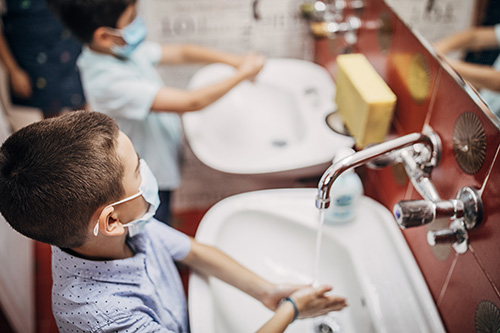One of the most important ways staff and children in schools can stay healthy is by keeping their hands clean throughout the day. In fact, school-based and Early Care and Education (ECE) programs promoting hand hygiene can result in less gastrointestinal and respiratory illness and fewer missed days. That’s why it’s important to encourage cleaning hands at key times with soap and water for at least 20 seconds or using an alcohol-based hand sanitizer with at least 60% alcohol if soap and water are not readily available.
Promote Hand Hygiene in Your School or ECE Program
- Teach and reinforce handwashing with soap and water for at least 20 seconds. Integrate hand hygiene lessons in K–12 school and ECE program curricula to regularly remind children of the importance of keeping hands clean.
- Build time into daily routines for children and staff to wash hands, especially at key times like after bathroom breaks, before lunch, or after playing outside. Take into consideration any additional time children or staff may need to wash their hands.
- Supervise and assist children with handwashing as needed. Younger children and children with certain disabilities (such as disabilities that limit their ability to move, or disabilities that make it difficult to follow instructions) may need help with washing their hands.
- Consider making hand sanitizers with at least 60% alcohol available for teachers, staff, and children.
- Hand sanitizer is not a substitute for cleaning hands with soap and water. However, hand sanitizers can be placed in areas where soap and water are not readily available (like cafeterias, classrooms, and gyms, for example) and near frequently touched surfaces, such as water fountains, doors, and shared equipment.
- Supervise young children under the age of 6 years, or children with certain disabilities, when they use hand sanitizer to prevent swallowing it or getting it in their eyes.
- Consider increasing access to hand hygiene infrastructure and supplies, such as sinks, soap dispensers, portable handwashing stations, and hand sanitizer dispensers. It is also important to provide a way for children and staff to dry hands by providing paper towels or hand dryers. Germs spread more easily when hands are wet, so making sure children and staff have a way to dry hands completely can help keep them safe. When hand hygiene facilities and supplies are available, children and staff are better able to make hand hygiene part of their routine.
- Place visual cues such as handwashing posters, stickers, and other materials in highly visible areas throughout the school—for example, bathrooms and locker rooms, classroom sinks, or cafeteria kitchens.
- Learn how to make a hygiene plan to help keep students safe. CDC’s Clean Hands and Spaces online training provides information on how to reduce the spread of germs through good hygiene habits and safety practices in K-12 schools and ECE settings.
- Know When and How to Use Hand Sanitizer
- CDC recommends washing hands with soap and water because handwashing effectively removes germs, dirt, and chemicals from hands. If soap and water are not readily available, using a hand sanitizer with at least 60% alcohol can help staff and children avoid getting sick and spreading germs to others.
- Hand sanitizers can quickly reduce the number of germs on hands in many situations. However,
- Hand sanitizers do not eliminate all types of germs, including some germs that cause diarrhea. Always wash hands with soap and water after using the toilet, after handling trash, and when hands are visibly dirty.
- Hand sanitizers may not be as effective when hands are visibly dirty or greasy. Hands are often dirty or greasy after activities like eating or playing outside.
- Hand sanitizers might not remove harmful chemicals, like pesticides and heavy metals, from hands.
- Prevent accidental poisoning
- Hand sanitizers should be stored up, away, and out of sight of children and should be used with adult supervision for children under 6 years of age or older children who have difficulty following instructions. Swallowing more than a couple of mouthfuls of an alcohol-based hand sanitizer can cause alcohol poisoning. In fact, calls to U.S. poison centers related to alcohol-based hand sanitizers increased by 36% from 2019 to 2020.
Source: https://www.cdc.gov/handwashing/handwashing-school.html



